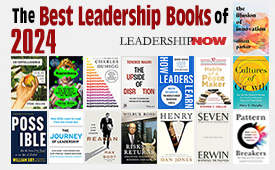 |
 |
04.18.25

The Leadership Blind Spot: Why Leaders Must Invest in Their Own Well-Being
STUDIES show that executive mental health is in a precarious state: 55% of CEOs in a recent 2024 study, for instance, self-reported they were having issues with their mental health. Given how private leaders tend to be about the pressures they’re under, imagine how many haven’t come forward. There’s an unspoken truth in high-level leadership: CEOs and executives bear the weight of their organizations alone, whether they admit it or not. No matter how many advisors, direct reports, or leadership partners surround them, they remain the ultimate decision-makers. Most also operate under the assumption that their primary role is to support everyone else — driving growth, ensuring profitability, and managing crises. Unlike mid-level managers, who have peers to turn to, CEOs and executives often find themselves with limited avenues for real support. Also, unlike mid-level managers, leaders are expected to lead at a relentless pace. Between balancing market pressures, investor demands, internal team dynamics, and personal ambition and managing the inherent isolation that comes with the job, executives’ own well-being takes a backseat. I call this the leadership blind spot. It should be no surprise to anyone that, over time, this burden takes its toll. Chronic stress, anxiety, and even physical health issues creep in, often unnoticed, until they start affecting performance. A leader’s unchecked sacrifice leads to burnout, poor decision-making, and diminished long-term effectiveness. Further, when a leader operates from a place of exhaustion, the entire organization feels it. Productivity suffers, culture weakens, and critical missteps become more frequent. The leader’s blind spot becomes the organization’s as well. Build a Core Dream Team If sustained success is the goal, then leaders must stop treating personal well-being as optional and start seeing it as a strategic investment. I was there myself and I’ve seen plenty of colleagues in the same position. But there’s a simple, commonsense way to overcome it. First, admit there’s a problem. Then, build a support team: a core dream team that focuses on a leader’s well-being, not just the usual organizational and management levers. Most CEOs surround themselves with financial, operational, and strategic advisors. However, this is a team for the lead executive, installed as a protective measure to support their personal resilience. Whether or not you believe you need them, you need them. They function as essential safeguards against the pressures of executive life. Here’s what the team should include: Personal leadership or performance coach: A leadership or performance coach serves as a sounding board, offering strategic guidance and helping executives maintain clarity amid complexity. They provide the external perspective leaders need to make better decisions and avoid blind spots (including neglecting one’s own well-being). Therapist or mental health professional: Emotional resilience is just as critical as financial acumen. Therapy equips leaders with tools to manage stress, process challenges, and maintain balance. Some of the most successful executives have publicly credited therapy for their ability to navigate high-pressure environments. The late Steve Jobs was known for seeking spiritual balance and integrating mindfulness and meditation into his leadership. In some cases, I’d even recommend a shaman over a traditional therapist—it depends on what resonates with the individual. Physical trainer: High-performing leaders understand that physical health directly correlates with mental clarity and stamina. Richard Branson has long credited his fitness regimen as a core factor in his productivity and creativity. CEOs like Tim Cook and Jeff Bezos prioritize fitness, knowing that a strong body fuels a sharp mind. Regular exercise mitigates stress, enhances focus, and boosts energy levels — key for sustained leadership performance. Nutritionist: Diet plays a direct role in cognition, mood, and overall energy. Many executives default to convenience eating — grabbing whatever’s available between meetings — without realizing the toll it takes on their performance. A nutritionist ensures they’re fueling their body and brain for optimal function over the course of an executive’s traditionally long day. Does a Co-CEO Help? I’ve been in discussions about the prospect of bringing in a co-leader or a co-CEO to share the burden. It’s a common question: wouldn’t having two people running the organization reduce the load by half?It might in the short term, but it’s rarely a sustainable solution. In the startup world, the co-CEO structure has gained traction. But I have yet to find an established company that has truly mastered this model. Consider Salesforce, often cited as a case study, in co-leadership. The organization has struggled to make it work. Marc Benioff, who founded Salesforce in 1999, first appointed Keith Block as co-CEO in 2018. But within two years, Block stepped down for undisclosed reasons. Benioff tried again in 2021, naming Brett Taylor as co-CEO. Again, it didn’t last: Taylor exited in 2023. What splitting the job doesn’t cover is the fact that the job itself requires multiple layers of support, and now an organization has two leaders who may be suffering from the same blind spot, not one. It is better to have a team surrounding the leader who can address well-being directly. High-Level Leadership Takes High-Level Health Executives often dismiss personal well-being as something they’ll “get to later.” Their schedules are packed. Their responsibilities are massive. And for many, there’s an ingrained belief that they’re somehow built differently—that they can endure more, push harder, and handle stress better than others. But the reality is the most effective leaders don’t just work hard—they take care of themselves so they can sustain that hard work over the long haul. By adopting the Core Dream Team model, leaders can protect themselves from burnout, sharpen their decision-making, and cultivate the resilience needed to thrive. Because high-level leadership isn’t just about driving business outcomes—it’s about sustaining the human behind the title. Those who recognize this truth will lead with greater clarity, impact, and longevity.  
Posted by Michael McKinney at 11:47 AM
|
BUILD YOUR KNOWLEDGE
 

How to Do Your Start-Up Right STRAIGHT TALK FOR START-UPS 
Grow Your Leadership Skills NEW AND UPCOMING LEADERSHIP BOOKS 
Leadership Minute BITE-SIZE CONCEPTS YOU CAN CHEW ON 
Classic Leadership Books BOOKS TO READ BEFORE YOU LEAD |